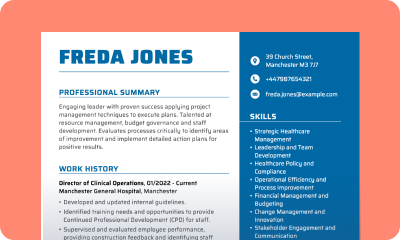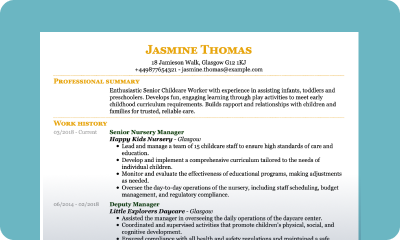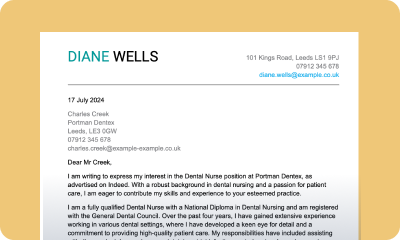- Our customers have been hired by : *Foot Note
Writing a CV for a CNC programmer can feel like a colossal task. It can be difficult to know what to write in a CV, but the online CNC programmer CV sample takes the guesswork out of the process, helping you to create a personalised and specific CV in the right format. Employers notice high-quality CVs and prioritise these for interview selection.
Are you ready to start this process? Let’s take a look at:
SEARCH ALL CV EXAMPLES
CNC programmer CV samples
Toby Williams 43 Iffley Road Bristol BS1 9NR 07912 345 678 Toby.Williams@example.co.uk Professional summary Experienced CNC Machine Operator with background in drilling, grinding and milling. Proficient with logistics and overseeing machines to determine functionality. Goal-oriented and meets timely deadlines. Work history February 2022 – Current Future Tech – Bristol CNC Setter/Programmer
- Optimised customer satisfaction, supporting Lean initiatives to drive continuous improvement.
- Confirmed that information was transferred between relevant team members before ending shift.
- Read, interpreted and communicated technical information.
- Guaranteed product quality, performing visual inspections and gauge measurements.
March 2019 – January 2022 Modern Engineering – Bristol CNC Programmer
- Used milling cutters, drills, taps and other CNC cutting tools safely and efficiently.
- Detected machine malfunction and made corrections to alleviate out-of-specification products.
- Identified and suggested process, method and tooling improvements.
- Guaranteed product quality, performing visual inspections and gauge measurements.
Skills
- Manual and CNC turning
- CNC metal cutting and boring
- Overhead crane operation
- Quality control inspections
- Electrical and mechanical repairs
- CNC programming
- Equipment operations
- Safety Procedures
Education 2018 Queen Mary’s University London Bachelor of Science Computer Science
Which format is right on a CV for CNC programmer applicants?
To build an engaging CV, you will want to begin with the right format. The structure of your CV must convey all the relevant information, whilst also being professional and simple to read. A good way to begin is to choose from a list of popular CV formats. This will allow you to pick a tried-and-tested layout that you can then tweak to fit your needs.
Whilst there are several styles that you can consider, there are two that stand out for most CVs. These are the reverse-chronological and skill-based CV. Reverse-chronological CVs act as a comprehensive guide to your work history, working backwards from either your current or most recent position. Skill-based CVs instead focus on transferable skills in place of first-hand experience in an identical job role.
You might be wondering which of these two is the best for a CNC programmer. It all depends on the experience you have. If you have direct experience in a similar position, then you can focus on this with a reverse-chronological CV. If you don’t, then you should opt for a skill-based CV that will highlight to your employers the indirect experience you have that makes you the right fit for the role.
Skill-based CVs are often the better choice if you are newly graduated or searching for an entry-level position. Most employers will understand that for an entry-level position, you won’t have any direct experience. You can instead highlight all the skills you have as a candidate, including qualifications and positive characteristics that will set you apart from the competition.
Here are some other things you’ll want to keep in mind:
- Make sure to adapt your CV so that it fits the job ad you’re applying for.
- Send your CV as either a PDF or Word document, unless directed otherwise.
- Ensure to keep your CV either one or two pages long.
- Use a legible, professional font like Arial Calibri or Times New Roman.
- Make sure to break-up long bodies of text with headings, sections, and bullet points.
How to write a CV for a CNC programmer
Once you’ve chosen the right template for you, it’s time to get right into the details. In the next section, we’re going to outline how to write a CV for a CNC programmer. We’re also going to cover a detailed guide on the most important things to include and answer some of your most pressing questions. In the next sections we’re going to cover:
- How to add contact details to your CNC programmer
- CNC Programmer CV personal statement
- Tackling work experience on a CV for a CNC programmer
- Top skills for your CNC programmer CV
- Outlining education on a CNC programmer CV
How to add contact details to your CNC programmer
The employers looking at your application will need to get into contact with you, so you’ll have to add your contact details early. General practice is to add this information somewhere near the header of your CV, in a bold font that makes it instantly noticeable. Make sure to include:
- Your full name – but you can leave out your middle name
- Location – so your employers get an idea of where you’re based
- Phone number – a mobile means you’re less likely to miss a call
- Email address – make sure to use a professional email address.
Example of contact section for CNC programmer CV
Simon Webb
1 The Boulevard,
Yourtown, Yourcounty,
Postcode
01243 623 326
s.webb@example.com
CNC Programmer CV personal statement
A personal statement is your opportunity to make a good first impression. Your personal statement acts as a way for your potential employer to get to know you as an employee. It will outline your qualifications, character traits, skills, and achievements. A good personal statement can feel tough to write as you will only have a few sentences to cover some important information. So then, what are some of the most important things to cover?
The first sentence you write is there to engage your employers, giving them a quick look into your experience and career goals. The second sentence should explain what you have achieved, featuring real examples. Sentences three and four are all about highlighting and special skills you have that make you stand out.
You’re likely wondering what we mean by ‘real world examples.’ In short, these will be facts or figures that act as supporting evidence for your claims. Let’s say you’ve already worked as a CNC programmer in the past – you can write something like ‘oversaw the reduction of cycle times by 15% on a complex aerospace component, leading to significant cost savings.’ A clear, real-world example is always going to be eye-catching.
Here are some other tips for a personal statement:
- Make sure it’s only 100 words.
- Ensure the tone is friendly but formal.
- Make sure to write it for the specific job you’re applying for.
- Always write in the third person as this is more professional.
- Don’t talk about future career goals – this can be saved for later.
Example of personal statement for CNC programmer CV
Highly skilled CNC programmer who can write program code in a variety of languages for power driven machines that cut and finish metal, wood and plastic. Extremely competent in preparing geometric layout of designs using software, determining the sequence of operations to be used in each program. Excellent knowledge of various tools used in programs, including operating speeds needed for maximum efficiency, simplifying tooling time for workers and increasing productivity for the client.
OR
Experienced CNC programmer, bringing a balance of technical expertise and innovative problem-solving to the manufacturing domain. Practical experience includes streamlining production for a complex automotive part, resulting in a 20% reduction in manufacturing time. Proficient in G-code and M-code and translating intricate engineering designs into precise machine instructions.
Tackling work experience on a CV for a CNC programmer
Another crucial part of a CV is the work history section. Tackling this effectively will mean the difference between success and failure, as it’s one of the first things an employer will look at. In this section, we’re going to look at how you can outline your biggest work achievements.
To write an effective work experience section, you will need to tailor it to the position you are applying for. Begin with your current or most recent role, noting up to six key responsibilities for each. Some of these may include:
- Job title
- Employment start and end dates
- Company name
- Company location
- List of key tasks
- Relevant work achievements
As we did in your personal statement, you want to add real-life examples of your achievements. For example, instead of writing “effective at reducing manufacturing time”, write “worked to reduce manufacturing time by 35%, helping to cut costs and improve efficiency”. This will make you sound more authoritative and professional.
The next thing to keep in mind is that you shouldn’t repeat yourself. By keeping your writing focused and direct, you will make the best first impression. An example of repeating yourself would be to write “improved efficiency” in one and “reduced inefficiency” in another. These are the same thing, so it’s important to just state this once with evidence and then move on to another responsibility or example.
It’s important to keep anybody who reads your CV hooked throughout. A good way to do this is to make use of action verbs and positive adjectives. Action verbs can be classified as anything that would replace “responsible for” in this section. Some of the words we like are “created”, “advised”, or “led”. When it comes to positive adjectives, describe yourself with an array of positive words like “effective”, “logical”, and “punctual”.
Example of work experience for CNC programmer CV
CNC Setter/Programmer, ABC Technical, Bristol | May 2022 – Present
- Worked as part of a team on programs for high precision components in the oil and gas industry.
- Produced a wide range of parts using Fanuc and Mazatrol languages.
- Read, interpreted and communicated technical information.
CNC Programmer | XYZ Engineering, Bristol, September 2016 – April 2022
- CNC programmer for Mazak four axis milling machines and lathes.
- Manufacturied new components based on specification and drawings using Mazatrol.
- Used milling cutters, drills, taps and other CNC cutting tools safely and efficiently.
Top skills for your CNC programmer CV
Every applicant needs a good CV skills section. This is because many employers may want to know if you have the relevant skills needed for the position straight away. Some companies may even use ATS software that will pick through your CV for important keywords that check if you meet the basic requirements. Since this is a possibility, you’ll want to add around 8-12 key skills. We will break these up into hard skills and soft skills.
So, what is the difference between these? Let’s take a look.
Soft skills: These are skills that could be described as personality-based, meaning they are character traits that make you a good employee. For example, some soft skills you could include would be “organised”, “punctual”, and “Innovative”.
Hard skills: By contrast, hard skills refer to technical skills learned through education or hands-on experience. For a CNC programmer, these would be skills like “proficient in G-code”, or “M-code”.
By adding a few of each, you will have a balance of skills that will make you stand out. Hard skills show you have the technical experience to perform a job with confidence, whereas soft skills show that you are a person that can be relied on.
Essential skills for a CNC programmer
- Superior computer programmer with extensive knowledge of metalwork.
- Excellent maths, physics and reading comprehension skills.
- Excellent written and verbal communicator and active listener.
- Superb problem solver.
Desirable aptitudes to set you apart
- Highly organised individual with excellent time keeping and planning skills.
- Able to write and interpret complex spreadsheets.
- Thorough knowledge of safety measures for each job.
- High attention to detail.
Outlining education on a CNC programmer CV
Your qualifications can be thought of as the foundation of your CV. These are especially important for candidates searching for entry-level positions. Outline in detail your university, college, and any school courses you have completed. Also include any additional qualifications you may have, including professional training, or membership of official governing bodies.
Make sure to add in only qualifications that are relevant and impressive to the job role that you are going for. This means highlighting qualifications that have led you to this application. Try to avoid any incomplete courses or poor grades you may have. Instead, make sure that all your qualifications are tailored to strengthen your CV.
You might also need to omit old qualifications that won’t help you. For example, if you have a university degree you probably won’t need to outline your GCSEs.
At this point you’re probably wondering what some of the basic requirements are to be a CNC programmer. Most employers will ask for a degree in a relevant field. An apprenticeship in CNC programming is also valuable but may not be enough on its own. Previous experience in a relevant position is often desired for entry-level positions, and essential for higher positions.
Here are some things to include:
- The name of the educational institution
- Your start and end dates of study
- Official title of your subject
- The level of your qualification
- Your qualification result
Example of education for CNC programmer CV
King’s College London | September 2019 – June 2022
BSc in Computer Science: First-class honours
South London College | September 2017 – August 2019
A Levels – IT, Business Studies, Maths
Dos and don’ts for your CNC programmer CV
A cover letter is one of the most important parts of your application – so don’t forget it! It is your way of introducing yourself to a potential employer in a formal way. It can be a way to go into detail about various parts of your CV, justify any holes in your employment history, and show how you are the right person for the job. The perfect cover letter will give the reader a total impression of you as a person, without using too many words. It can be difficult to write a tailored cover letter for every position, but it is vital that you do.
CNC programmers are specialists. Any special skills that you have should be highlighted as quickly as you can – as early as your personal statement. This allows anybody reading your CV to quickly understand that you have the right skills for the job in question.
Errors are not something you want in your CV. By making sure everything is proof-read, you will show to your employer that you have an eye for details. You should also make sure that the entire CV is easy to read and engaging. A good way to do this is to pass it along to a trusted friend, family member, or colleague. If they can understand it, then there’s a good chance it will read well to a potential employer.
Make sure to tailor your CV to each job you are applying to. Doing this is one of the most effective ways to make your CV personal and direct. Employers will notice this and it’s much more likely that you will get a call back.
Your CNC programmer CV questions answered
What are the common duties of a CNC programmer?
CNC programmers are responsible for creating and optimising computer numerical control (CNC) programs that guide machines to shape and cut materials into precise components. Some common duties may include:
- Interpreting engineering plans
- Selecting appropriate tools
- Configuring machine settings
- Ensuring adherence to quality standard
- Troubleshooting
What soft skills do you need to be a CNC programmer?
Soft skills crucial for CNC programmers include attention to detail to ensure precision, problem-solving abilities to address programming challenges, effective communication for collaboration with colleagues, adaptability to new technologies, teamwork to coordinate with engineers and operators, and a commitment to workplace safety.
How much does a CNC programmer earn?
Salaries for CNC programmers in the UK vary based on experience, location, industry, and company size. On average, an entry-level CNC programmer might earn around £20,000 to £30,000 per year. With experience, this can increase to £30,000 to £40,000 or more for senior roles. High-demand sectors like aerospace or automotive can offer higher salaries.
Do you need specific qualifications to work as a CNC programmer?
While a high school diploma or equivalent is often the minimum requirement, having technical qualifications such as a degree, diploma, or vocational training in engineering, manufacturing, or related fields can enhance your employability. Proficiency in CNC programming languages (G-code, M-code) and familiarity with CAD/CAM software are crucial qualifications for the role.
Related Manufacturing CV
Create an effective CNC programmer CV today!
To create an effective CNC programmer CV, you can make use of our tools and CV builder for further guidance. The samples above are a surefire way to make a CV that will give you the best chance of landing your dream job! If you want more resources to help you with the application process, consider some more CV examples and CV templates.
*The names and logos of the companies referred to above are all trademarks of their respective holders. Unless specifically stated otherwise, such references are not intended to imply any affiliation or association with myperfectCV.




